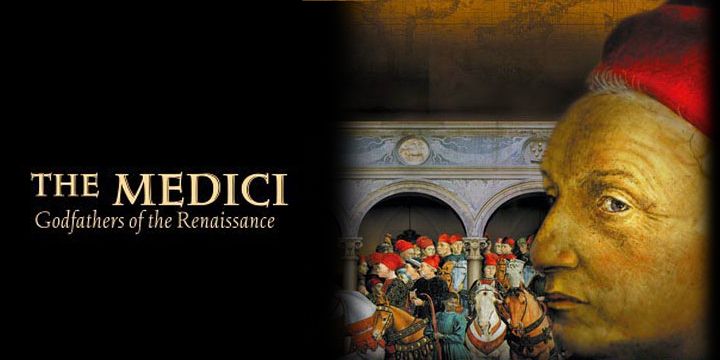The Medici – Godfathers of the Renaissance: From a small Italian community in 15th-century Florence, the Medici family would rise to rule Europe in many ways. Using charm, patronage, skill, duplicity and ruthlessness, they would amass unparalleled wealth and unprecedented power.
The Medici – Birth of a Dynasty part 1
Europe, 1400: A continent torn apart by war and plague is dominated by the authority of the Catholic Church. In the towns and cities live merchants and entrepreneurs who sense that their world is changing. With increasing trade and wealth an appetite for enlightenment develops. No longer neglected in the shadows of the Church, classical philosophy, poetry, art and sculpture begin to reach a new audience. This is especially true in cosmopolitan cities like Florence, home of Cosimo de’Medici.
The Medici – Godfathers of the Renaissance – Magnificent Medici part 2
Florence, August 1466: Lorenzo de’Medici, the 17-year-old heir to the dynasty, foils a murderous plot against his father and saves his family from a coup d’etat. The Medici still dominate Florence, but now take extra precautions, picking a useful bride for Lorenzo. Clarice Orsini, a baron’s daughter and cardinal’s niece, brings connections, class, and military muscle to the Medici dynasty.
The Medici – Medici Popes part 3
Florence, 1501: 26-year-old Michelangelo carves a giant masterpiece which will come to symbolize his struggle against a family he once adored. Raised from a young age alongside the Medici heirs he watched as they were cast into exile with a price on their heads. Now they are searching for a path back to power.
The Medici – Godfathers of the Renaissance part 4
Florence, 1537: Alessandro de’Medici the Duke of Florence, lies murdered in his bed. His cousin is plucked from obscurity to lead Florence. He is just 17. His rivals think he’s a puppet, but despite his youth, Cosimo de’Medici, the new Duke of Florence, is ambitious.
They would also ignite the most important cultural and artistic revolution in Western history–the European Renaissance. But the forces of change the Medici helped unleash would one day topple their ordered world. An epic drama played out in the courts, cathedrals and palaces of Europe, this series is both the tale of one family’s powerful ambition and of Europe’s tortured struggle to emerge from the ravages of the dark ages.
A tale of one family’s powerful ambition and of Europe’s struggle to emerge from the ravages of the Dark Ages. Beginning in the 14th century, The Medici used charm, skill and ruthlessness to garner unparalleled wealth and power. Standing at the helm of the Renaissance, they ruled Europe for more than 300 years and inspired the great artists, scientists and thinkers who gave birth to the modern world.
Cosimo de’ Medici
Cosimo di Giovanni de’ Medici, called “the Elder” and posthumously “Father of the Fatherland” (27 September 1389 – 1 August 1464), was an Italian banker and politician, the first member of the Medici family that de facto ruled Florence during much of the Italian Renaissance. Despite his influence, his power was not absolute; Florence’s legislative councils at times resisted his proposals throughout his life, and he was always viewed as primus inter pares (“first among equals”) rather than an autocrat. His power derived from his wealth as a banker, and he was a great patron of learning, the arts and architecture.
Lorenzo de’ Medici
Lorenzo de’ Medici ( 1 January 1449 – 8 April 1492) was an Italian statesman, de facto ruler of the Florentine Republic and the most powerful and enthusiastic patron of Renaissance culture in Italy. Also known as Lorenzo the Magnificent by contemporary Florentines, he was a magnate, diplomat, politician and patron of scholars, artists and poets.
As a patron, he is best known for his sponsorship of artists such as Botticelli and Michelangelo. He held the balance of power within the Italic League, an alliance of states that stabilized political conditions on the Italian peninsula for decades, and his life coincided with the mature phase of the Italian Renaissance and the Golden Age of Florence. The Peace of Lodi of 1454 that he helped maintain among the various Italian states collapsed with his death. He is buried in the Medici Chapel in Florence.




